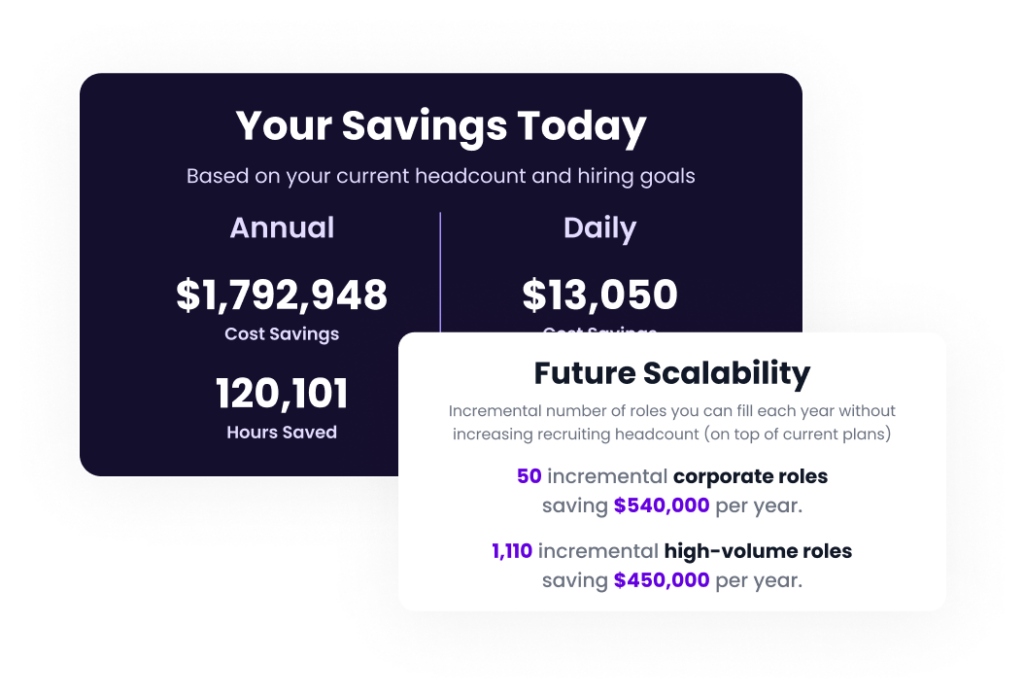High-volume recruiters, get your texting fingers ready. When you need to fill roles fast and efficiently, text recruiting is the way to go. (It’s the digital age—every candidate’s on their phone.) But you know what’s even better? Using text recruiting templates.
Why settle for crafting individual messages when you can templatize every single one, from the initial outreach to the offer letter? To save both time and effort, here are our 15 crucial text recruiting templates.
If you’re interested in even more ways to elevate your hiring, check out our collection of key high-volume recruiting strategies.
Essential Text Recruiting Templates
Want to reach out to an employee referral and avoid the awkwardness? Or maybe you want to reject a candidate while keeping the good vibes going? We’ve got a template for that.
1. Initial Outreach
Introduce yourself to the candidate and gauge their interest in working for your company.
Hi [Candidate’s Name]! This is [Your Name] from [Company Name]. I came across your profile and was impressed by your qualifications. We have a job opening that aligns perfectly with your skills. Would you be interested in discussing this further?
2. Job Opportunity
Highlight a specific job opportunity and ask to schedule a call.
Hi [Candidate’s Name]! [Your Name] here from [Company Name]. We have a [Job Title] role that matches your expertise. The position involves [brief description]. If you’d like to learn more, let’s schedule a quick call.
3. Employee Referral Outreach
Reach out to a candidate that you’ve sourced via an employee referral.
Hi [Candidate’s Name]! [Employee’s Name] spoke highly of you and recommended you for a [Job Title] role at [Company Name]. Can we set up a time to chat and discuss the details?
4. Networking Event Outreach
Connect with potential candidates you met through networking events.
Hi [Candidate’s Name], this is [Your Name]. It was great to meet you at [Networking Event]. I was impressed by our conversation and thought you might be a great fit for a position at [Company Name]. Let’s schedule a call if you’d like to learn more.
5. Application Reminder
Remind the candidate about their partially completed application and encourage them to continue.
Hi [Candidate’s Name], [Your Name] here from [Company Name]. We noticed you started an application for [Job Title]. We’d love to learn more about you and see if you’re a good fit for the role. Please reach out with any questions; we’re here to help!
6. Application Received
Confirm receipt of the candidate’s application.
Hi [Candidate’s Name]! Just a quick message to let you know we received your application for the [Job Title] position at [Company Name]. We appreciate your interest and will be in touch soon if there’s a match. Thanks!
7. Application Status Update
Inform the candidate about the status of their application.
Hi [Candidate’s Name]! I wanted to update you on the status of your application. At this time, we are still in the process of reviewing applications and will be in touch soon with further updates. We appreciate your patience and interest in joining [Company Name].
8. Scheduling the Phone Screening
Schedule an initial phone screening after reviewing a candidate’s application.
Hi [Candidate’s Name]! Thanks for your interest in the [Job Title] position at [Company Name]. I’d love to connect with you for a quick phone screening. Please book a time that works best for you: [Scheduling Link]
9. Scheduling the Next Interview
After the phone screening, extend an invitation for an interview with the team.
Hi [Candidate’s Name], we’d love to move you to the next round of interviews with the team. Please book a time that works best for you: [Scheduling Link]
10. Interview Confirmation
Confirm a candidate’s upcoming interview and offer the option to reschedule if needed.
Hi [Candidate’s Name], we’re looking forward to continuing the conversation with you! Your interview with [Interviewer Name] is scheduled for [Date] at [Time]. Please reach out if you have any questions. You can use this link if you need to reschedule: [Scheduling Link]
11. Interview Reminder
Remind a candidate of the details for their next interview.
Hi [Candidate’s Name], friendly reminder that your interview with [Interviewer Name] for the [Job Title] role is coming up. We’re excited to speak with you on [Date] at [Time]. Please let us know if you have any questions. You can reschedule if needed here: [Scheduling Link]
12. Job Offer
Extend a job offer to the candidate and provide details for further discussion.
Hi [Candidate’s Name], great news! We were impressed by your skills and would like to extend a job offer. I’ve attached the details, including the offer letter. Looking forward to hearing your decision!
13. Follow-Up After Job Offer
Check-in with the candidate who hasn’t accepted or rejected your job offer yet.
Hi [Candidate’s Name]! I wanted to touch base and see if you have any additional questions or if there’s anything else we can provide to help you make your decision. We look forward to hearing from you!
14. Onboarding
Provide essential information and instructions to candidates who have accepted the job offer.
Hi [Candidate’s Name], congratulations once again on accepting our job offer! We’re thrilled to have you join our team. To kickstart the onboarding process, I’ve attached a detailed outline of what to expect. We’re excited to welcome you!
15. Rejection Notice
Inform the candidate that they were not selected to move forward.
Hi [Candidate’s Name], thank you for your interest in [Company Name]. After careful consideration, we have decided to not move forward with your application. We appreciate your time and wish you the best in your job search. Keep an eye on our future opportunities!
Amp Up Your High-Volume Recruiting
Text recruiting and high-volume recruiting go together like peanut butter and jelly. But text recruiting templates is the secret ingredient you’re direly missing.
With these 15 versatile templates, you can save time and engage with mass amounts of candidates more efficiently. And if you want to take your high-volume recruiting game to the next level, we have just the tool for you.
GoodTime gives talent teams advanced automated interview scheduling for high-volume roles through SMS, WhatsApp, and email messaging. Reach out to candidates quickly, schedule interviews effortlessly, and let automation take care of the rest.
See how we can revolutionize your high-volume recruiting.
Human-centric AI to crush your high-volume hiring goals
Engage candidates immediately via SMS and WhatsApp, harness instant bulk scheduling, and automate hiring workflows.





